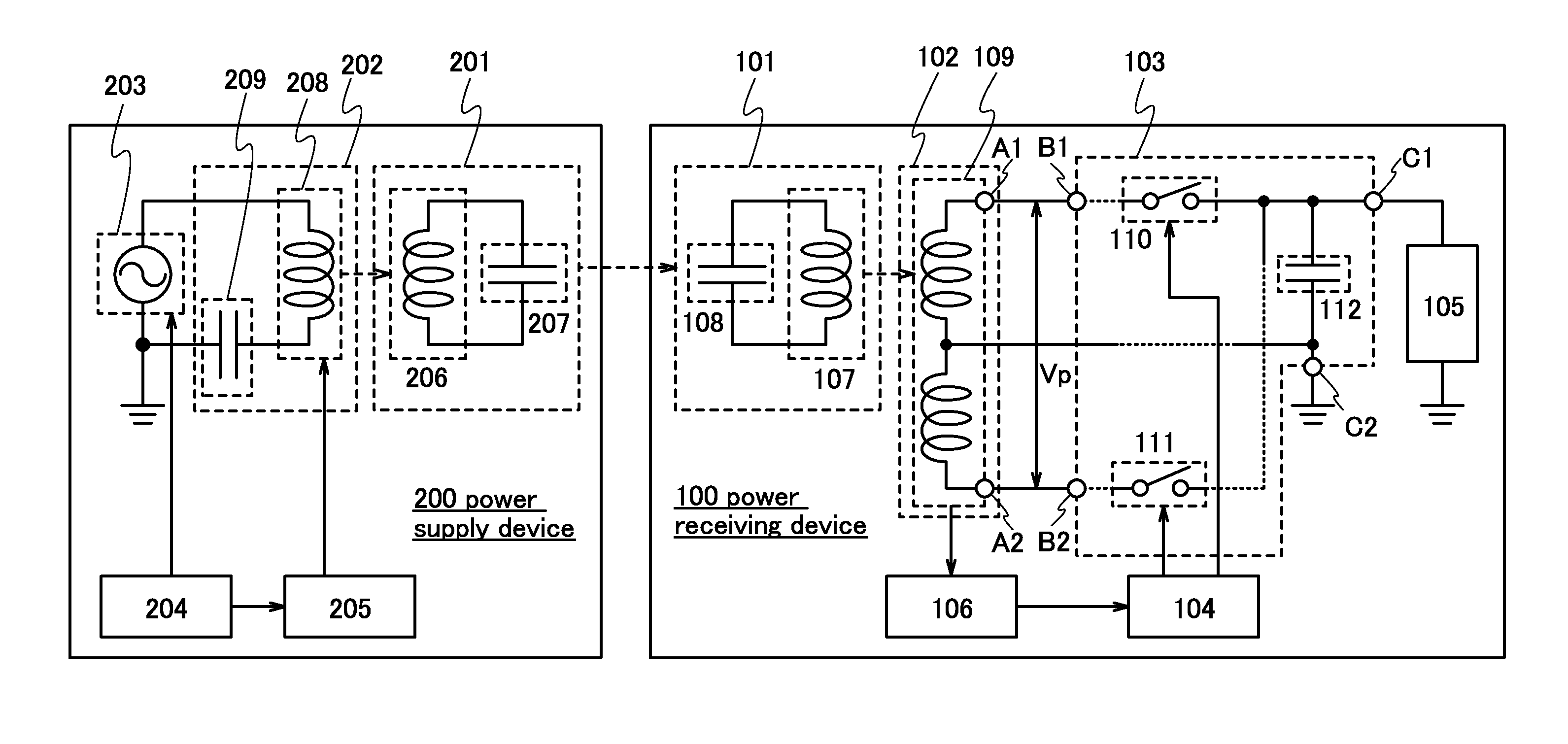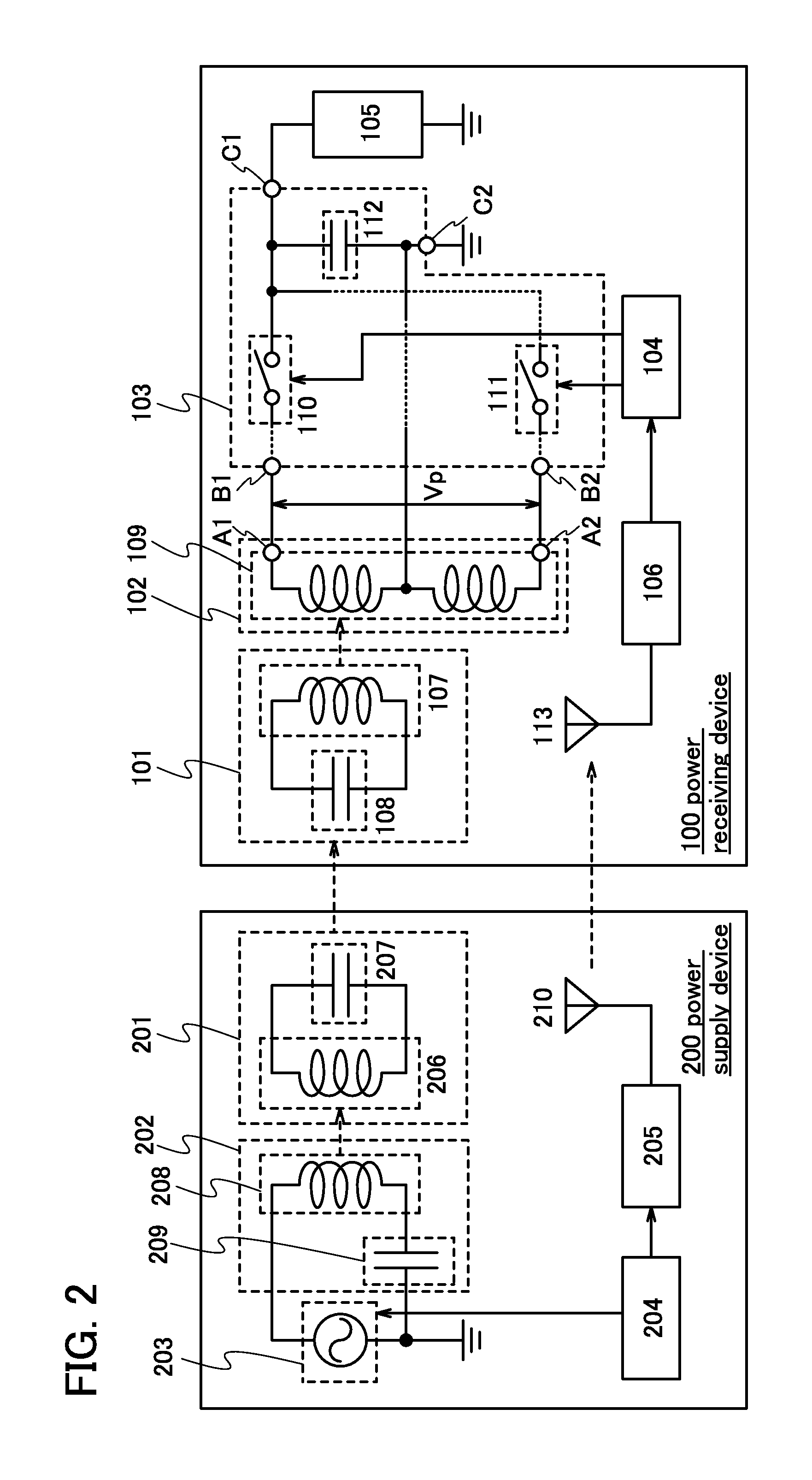Power receiving device and wireless power supply system
wireless technology, applied in the direction of safety/protection circuits, inductances, transportation and packaging, etc., can solve the problems of low power transmission efficiency of total power transmitted, power consumption, and low power transmission efficiency of power supplied to a power receiving device while charging, so as to improve power transmission efficiency, reduce q-value, and high power transmission efficiency
- Summary
- Abstract
- Description
- Claims
- Application Information
AI Technical Summary
Benefits of technology
Problems solved by technology
Method used
Image
Examples
embodiment 1
[0031]FIG. 1 illustrates an example of a wireless power supply system according to one embodiment of the present invention. The wireless power supply system in FIG. 1 includes a power receiving device 100 and a power supply device 200.
[0032]The power receiving device 100 includes a resonant antenna 101, a power receiving antenna 102, a rectifier circuit 103, a control circuit 104, a load 105, and a receiving circuit 106. Further, the power supply device 200 includes a resonant antenna 201, an antenna 202, an AC power source 203, a control circuit 204, and a transmitting circuit 205.
[0033]First, a specific structure of the power supply device 200 is described.
[0034]The resonant antenna 201 includes an antenna element 206 that is an inductor and capacitance in the antenna element 206. Further, in order to adjust the resonant frequency of the resonant antenna 201, a capacitor may be connected to the antenna element 206 in addition to the capacitance in the antenna element 206. In FIG. ...
embodiment 2
[0076]In this embodiment, the structure of the power receiving device 100 which uses a power storage device as the load 105 is described.
[0077]FIG. 5 illustrates the structure of the power receiving device 100 according to one embodiment of the present invention. The power receiving device 100 in FIG. 5 is different from the power receiving devices 100 in FIG. 1 and FIG. 2 in the structure of the load 105. In FIG. 5, the load 105 includes a power storage device 114 and a charge control circuit 115. Note that the load 105 may include a load in addition to the power storage device 114 and the charge control circuit 115.
[0078]Current is supplied to the power storage device 114 using voltage transmitted from the rectifier circuit 103, whereby charge is stored in the power storage device 114; therefore, power is stored in the power storage device 114. The power storage device 114 includes at least a pair of input terminals; charge is supplied from one input terminal and a reference poten...
embodiment 3
[0087]The present inventor measured loss of power transfer in wireless power supply from a power supply device to a power receiving device. In this embodiment, the results are described.
[0088]The loss of power transfer was measured using different three conditions. Under a first condition, as shown in FIG. 6A, a power supply device 301 and a power receiving device 303 were used. In the power receiving device 303, it is estimated that the first operation was performed in a rectifier circuit. Under the first condition, the power receiving device 303 was arranged within a region where a radio wave outputted from the power supply device 301 could be received.
[0089]Under a second condition, as shown in FIG. 6B, the power supply device 301, the power receiving device 303, and a power receiving device 304 were used. In the power receiving devices 303 and 304, it is estimated that the first operation was performed in the rectifier circuit. Under the second condition, the power receiving dev...
PUM
 Login to View More
Login to View More Abstract
Description
Claims
Application Information
 Login to View More
Login to View More - R&D
- Intellectual Property
- Life Sciences
- Materials
- Tech Scout
- Unparalleled Data Quality
- Higher Quality Content
- 60% Fewer Hallucinations
Browse by: Latest US Patents, China's latest patents, Technical Efficacy Thesaurus, Application Domain, Technology Topic, Popular Technical Reports.
© 2025 PatSnap. All rights reserved.Legal|Privacy policy|Modern Slavery Act Transparency Statement|Sitemap|About US| Contact US: help@patsnap.com



